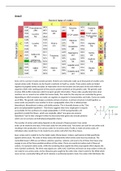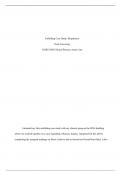Group B
Every cell in a person’s body contains protein. Proteins are molecules made up of thousands of smaller units
named amino acids. Proteins can be found in nutrients in food E.g. meats. These amino acids are linked
together by peptide bonds and plays an important role in the function and structure of the cells within an
organism. DNA is the starting point of the process protein synthesis as the genetic code. The genetic code
involves DNA & RNA molecules which transport genetic information. These codes usually determine what
reactions can or cannot occur within the human body. The codes for the enzymes are controlled by genes,
depending on which enzymes are made can regulate an organism’s characteristics and traits. Genes are made
up of DNA. The genetic code shapes a proteins primary structure. A primary structure is held together as
amino acids are joined to one another to form a polypeptide chain, this is called protein
biosynthesis. Biosynthesis is where cells build proteins. This is formally known as the “One
gene and polypeptide hypothesis”. This theory suggests that every single gene is majorly
accountable for the synthesis of a single polypeptide. In 1945 George Bundle a US
geneticist created this theory, which was originally called “one gene-one enzyme
hypothesis” but he later changed it when he discovered that genes also encode proteins
which are non-enzyme and individual polypeptide chains.
The number of amino acids solely depends on the amount of bases present. Four amino
acids can be made by one base, if the base codes for one amino acid. Two bases can code for one amino acid
resulting in the production of 16 various codes for 16 amino acids. Finally, to make 20 amino acids, 64
individual codes would have to be made by one amino acid which has three bases.
Every amino acid is coded for by the triplet codon (three bases). Codons, particularly in RNA specifically
appoint amino acids. The order of these bases will determine which amino acid must be produced. The
nucleotide bases in RNA are as follows; adenine, guanine, cytosine, and uracil. Any of these four bases may
engage in one of the three possible positions of the codon. There are exactly 64 codons and of these 64
codons, 61 represent amino acids, while the remaining three signify the three stop signals which depute the
end of protein synthesis. The three stop signals are; UAA, UAG, UGA they are known as stop codons as they do
not code for any amino acids. As the ribosome gets caught by the UAA, UAG, UGA it waits for the tRNA which
never arrives, eventually falling off and it releases a synthesised protein. Next, the codon AUG distributes the
Every cell in a person’s body contains protein. Proteins are molecules made up of thousands of smaller units
named amino acids. Proteins can be found in nutrients in food E.g. meats. These amino acids are linked
together by peptide bonds and plays an important role in the function and structure of the cells within an
organism. DNA is the starting point of the process protein synthesis as the genetic code. The genetic code
involves DNA & RNA molecules which transport genetic information. These codes usually determine what
reactions can or cannot occur within the human body. The codes for the enzymes are controlled by genes,
depending on which enzymes are made can regulate an organism’s characteristics and traits. Genes are made
up of DNA. The genetic code shapes a proteins primary structure. A primary structure is held together as
amino acids are joined to one another to form a polypeptide chain, this is called protein
biosynthesis. Biosynthesis is where cells build proteins. This is formally known as the “One
gene and polypeptide hypothesis”. This theory suggests that every single gene is majorly
accountable for the synthesis of a single polypeptide. In 1945 George Bundle a US
geneticist created this theory, which was originally called “one gene-one enzyme
hypothesis” but he later changed it when he discovered that genes also encode proteins
which are non-enzyme and individual polypeptide chains.
The number of amino acids solely depends on the amount of bases present. Four amino
acids can be made by one base, if the base codes for one amino acid. Two bases can code for one amino acid
resulting in the production of 16 various codes for 16 amino acids. Finally, to make 20 amino acids, 64
individual codes would have to be made by one amino acid which has three bases.
Every amino acid is coded for by the triplet codon (three bases). Codons, particularly in RNA specifically
appoint amino acids. The order of these bases will determine which amino acid must be produced. The
nucleotide bases in RNA are as follows; adenine, guanine, cytosine, and uracil. Any of these four bases may
engage in one of the three possible positions of the codon. There are exactly 64 codons and of these 64
codons, 61 represent amino acids, while the remaining three signify the three stop signals which depute the
end of protein synthesis. The three stop signals are; UAA, UAG, UGA they are known as stop codons as they do
not code for any amino acids. As the ribosome gets caught by the UAA, UAG, UGA it waits for the tRNA which
never arrives, eventually falling off and it releases a synthesised protein. Next, the codon AUG distributes the











